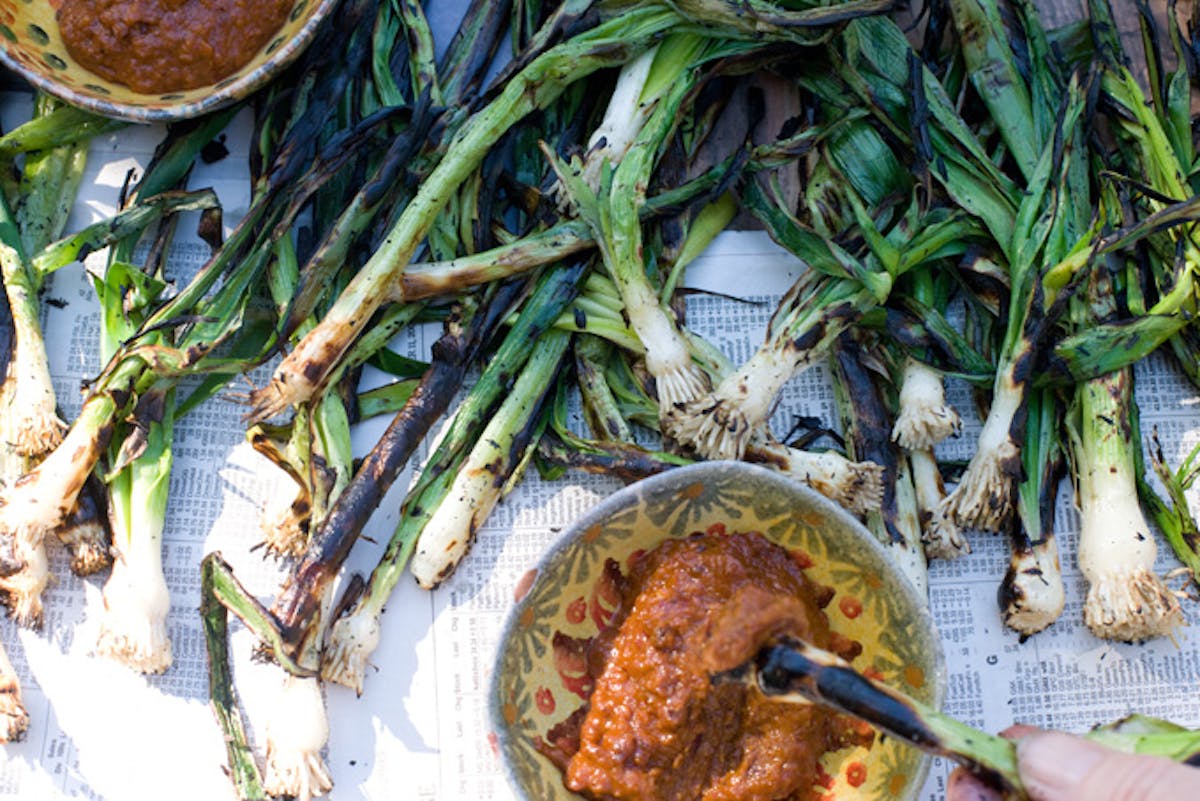More Favorite Ingredients
A simple list of some of the ingredients that are in high rotation in my kitchen - from beans to lentils, sprouts to seitan.

This list is by no means complete. I'll continually update this list with new ingredients and new notes on ingredients I've already included here.
Chives: If I had to choose just one culinary herb to use, it would be a tough battle between chives, basil, and thyme, but I think I would go with chives, the most diminutive of the alliums. Most chives have a mild, herbal onion flavor. Garlic chives have flatter leaves and, not surprisingly, a garlic flavor. Use either as a garnish anytime you want to impart a mild garlic or onion flavor. They're especially good in spring and summer soups, stir-fries, soufflés, panini, eggs, and crepes. A few chive recipes.
Cruciferous Vegetables: I can't get enough of these nutritional powerhouses. broccoli, cauliflower, brussels sprouts, and cabbage, turnips, mustard greens, collards, and kale.
Dried Beans: Each bean has a unique flavor profile, appearance, and texture. Some beans are thin-skinned and prone to rupturing when heated to anything more than a delicate simmer. Others are sturdy and stay intact, even in the proximity of a cook with a hot-tempered stove and a less-than-watchful eye. Some dried beans start their journey to the table bold and showy, with colorful markings and beguiling patterns, while others are simple and nondescript. Sadly, their markings and colors often fade into faint whispers of their former vibrancy as they rehydrate and plump up in a pot of bubbling water.
Nutritionally, beans are a powerhouse of soluble fiber, iron, and protein. Seek out beans that have been harvested and dried within the past year or so. Dried beans that have been sitting around for years take longer to cook, are more difficult to rehydrate, and are generally more difficult to work with and prepare. They may also be less nutritious. And be sure to look for heirloom varieties. Store beans in a dark cupboard where they will retain their brightness and vitality; some of their nutrients deteriorate quickly when exposed to light. A few favorite bean recipes.
Eggs: I buy the best eggs I can find, and use them a thousand different ways. The difference between cheap,industrially farmed eggs and the kind I pick up at my farmers market is remarkable and if you eat eggs I encourage you to seek out farm fresh eggs that are produced by chickens that are treated well. Egg recipes.
Garlic: Raw garlic has the strongest and most robust flavor of the alliums, and the flavor is intensified the more finely it's chopped. Cooking mellows their flavor, and roasting or toasting whole cloves until they caramelize and ooze out of their paper skins reveals a hidden sweetness. Garlic scapes are the plant's delicious but fleeting flower stalks. Look for them at farmers' markets in spring. You may occasionally find scapes from other alliums, such as leeks. They're delicious chopped and blended into fresh cheeses or in soups. Lot's of garlic recipes here.
Lentils: As a longtime shutterbug, I find it endearing that the optical lens is named after the lentil (Latin for lens), whose shape it echoes. The big upside to cooking with lentils is that they are substantial, filling, highly nutritious, and relatively quick to cook. They are great cooked into stews, mashed into spreads, molded into croquettes of all sizes, and mixed into grain-based salads. Plus, unlike most dried beans, they require no presoaking. Some varieties of lentils hold their shape, while others have a tendency to turn quickly to mush. I've found that the peppery green Le Puy lentils, from France, hold their shape nicely, as do the sexy black beluga lentils. I'm often tempted by the vibrant hues of the red and yellow varieties, but because they lose structure so quickly they are best in pureed soups or more traditional Indian preparations, such as dal. Don't let their diminutive stature fool you; lentils have one of the richest protein profiles of any vegetable, backed up with supersized levels of iron, fiber, and folate. Lentil recipes.
Nuts & Seeds: Nuts and seeds are high in fat, but in contrast to many of the processed fats that work their way into our diets these are natural, straight-from-the-source fats with their healthful properties intact. Start by considering a whole nut, and then imagine all the directions you can go from there. Toast that nut and the flavor becomes more pronounced. Chop it and you have a crunchy, textural element to play with. Mill it into a flourlike meal and you have an ingredient that can be used to add flavor and moisture to baked goods or to deliciously thicken a pureed soup. Grind it and you have a spread or butter. Or blend it with water to make a nut milk. Start thinking about seeds similarly. They are wonderfully diverse and span a broad range of colors, shapes, flavors, textures, and origins. Nut recipes.
Because of their naturally high fat content, nuts and seeds can quickly go rancid. For this reason, commercial walnuts are often treated with powerful chemicals to extend shelf life. Seek out good sources with fresh stock, and store them refrigerated. Nuts that are sold sliced or chopped are much more likely to be rancid upon purchase than whole nuts, and your best bet is nuts still in shell. The shells, or even the skin as on an almond or hazelnut, adds a layer of protection from light and heat, which can cause rancidity. Because of their high fat content, it's especially important to buy organic nuts and seeds. Or buy them at a farmers' market, where you can ask the grower about their methods.
Miso:There are many uses for miso beyond the traditional soup you're probably familiar with. This healthful, fermented soybean paste can be used as a seasoning, as a rich base for a stock, and in sauces, dressings, and marinades. Look for unpasteurized, naturally fermented miso in the refrigerator section of natural foods stares and start exploring the wide range available. The lighter, creamy-colored misos are more delicate in flavor than the darker, brown versions. Miso recipes.
Tempeh: Tempeh recipes.
Tofu: Tofu recipes.
Sea Vegetables: A rich palette of sea vegetables awaits your discovery. They range in flavor from mild to strong and can be used to infuse a tempered saltiness and a spectrum of hard-to-get trace minerals into many recipes. They typically contain up to twenty times the minerals of land-grown vegetables. Sea vegetables are primarily available in dried form, which can be used as is in soups and broths. Rehydrated, they can be added to endless dishes; just soak until tender, which only takes about 5 minutes. Some types expand quite dramatically in liquid, so use a light hand until you get a feel for how much expansion to expect with each. Toasted and crumbled, they can be used as a seasoning. If you aren't used to eating sea vegetables, start with milder types, such as arame, nori, and wakame, and work your way up to hijiki, which is much stronger and actually a bit overpowering for my tastes.I believe it is Wakame that is the variety you often find in the bottom of your miso soup, and kombu is a natural flavor enhancer that can be used as an alternative to MSG. For a real treat, keep your eyes peeled for fresh sea beans, or samphire. Though not technically a sea vegetable, it grows in salt marshes and coastal estuaries and along rocky ocean shorelines, so in my book it qualifies. Their quirky shape, vibrant color, and surprise saltiness make them delightful to bite into raw. They are also wonderful sautéed for just a minute or two in just a touch of good-quality olive oil.
Agar is a sea vegetable that you're probably already eating without knowing it. An effective thickener that can be used in place of gelatin, it often makes an appearance in yogurt. Unlike gelatin and other thickeners, agar will set up at room temperature, making it more versatile. I go into this ingredient in more depth in Super Natural Cooking, I use it in a gelatin-free panna cotta.
Seitan:
Shallots have a much more refined flavor than garlic, and because of their relatively low water content, their flavor is beautifully concentrated. I use them often--sautéed or pan-fried and crunchy on tops of soups and salads, roasted whole, and raw in vinaigrettes and a few dips. Shallot recipes.
Soy Sauce:One of the building blocks of Asian cuisine, soy sauce is a salty sweet condiment adds rich, complex depth to almost any food. The key is buying naturally fermented soy sauce made from whole ingredients using traditional methods. Chemically processed, fast-tracked soy sauce, often produced in a single day, is a harsh-tasting distant relative to the real thing. I prefer all-natural, organic, unpasteurized shoyu, which is available in most natural foods stores.
Sprouts: Sprouting grains, legumes, and seeds boosts their already commendable nutritional profiles. There is a lot of power and aspiration in that little sprout. Sprouts are also easier for the body to digest, so if you have had trouble with certain beans, try eating them sprouted. While growing your own sprouts is certainly an option, a wide variety of sprouts are increasingly available at farmers' markets and in produce departments. Look for bright, fresh-looking sprouts and give them a sniff to make sure there's nothing funky going on.
Tea: Up until recently, green tea has received the lion's share of accolades on the health front, primarily because it was the tea studied most extensively, but all teas are brimming with beneficial antioxidants, so enjoy exploring the spectrum. There are many ways to enjoy tea beyond just drinking it. For example, I often grind up tea leaves with a mortar and pestle and use them as a seasoning, opening up a whole new world of flavors. Rehydrated and chopped, you can use tea leaves in stir-fries, omelets, stuffings, and anything else you can dream up. Start with judicious amounts and build from there. Use too much and the tea's flavor can easily overpower other ingredients.
Vinegar:The word vinegar stems from the French for "sour wine"-- vin aigre. Unfortunately, much of the vinegar you encounter on supermarket shelves is a speed-aged imposter of their naturally fermented cousins . Look for naturally fermented vinegars that are unpasteurized, unfiltered, and traditionally crafted. You want vinegar with a taste reminiscent of the source it came from and anything that can be made into alcohol can conceivable be turned into vinegar. Good choices include apple cider vinegar made from fermented fresh-pressed apple juice and wine vinegar aged traditionally.
Yogurt: Look for fresh organic yogurt rich in live active cultures, or if you are more ambitious, try making your own. The live cultures in yogurt help maintain an optimum balance of microorganisms in the digestive tract. This supports healthy digestion, strengthens the immune system, and provides a host of other benefits. Yogurt isn't just for breakfast or a quick snack; it has limitless culinary possibilities. If you wrap it in cheesecloth and let it drain, you'll end up with creamy, delicious yogurt cheese, to which you can add herbs, spices, or citrus zest for a savory spread or berries and honey if you're after something sweeter. Unsweetened plain yogurt is the perfect base for many dips, and there are endless yogurt recipes, both sweet and savory here on the site.


